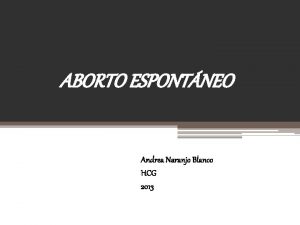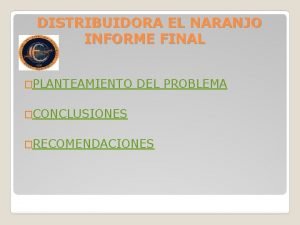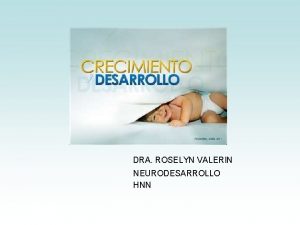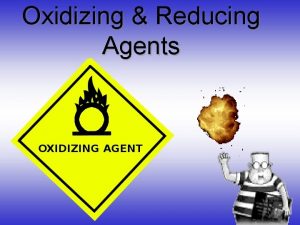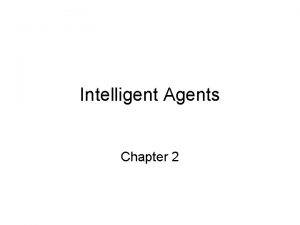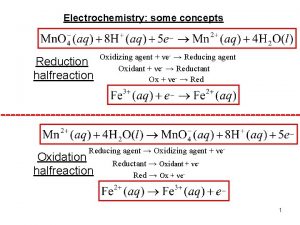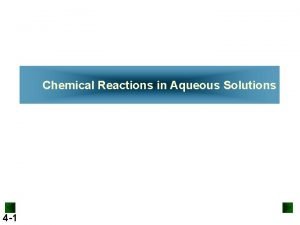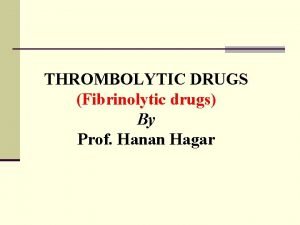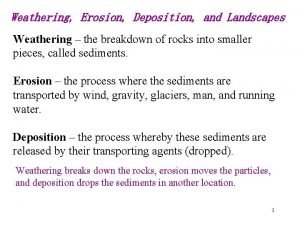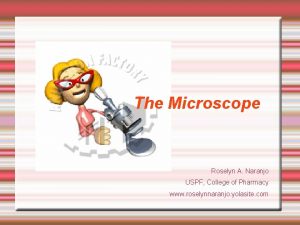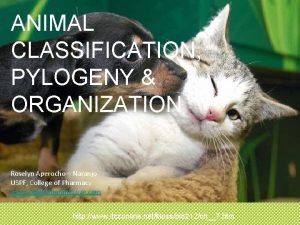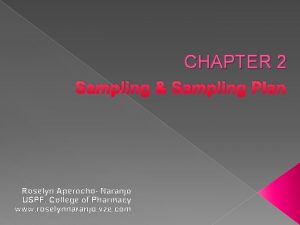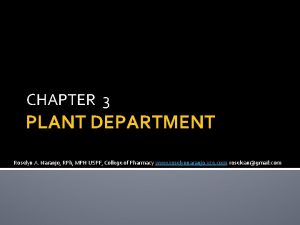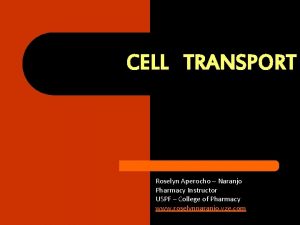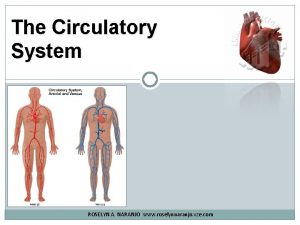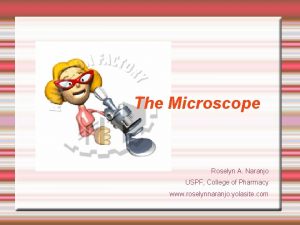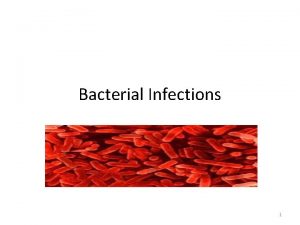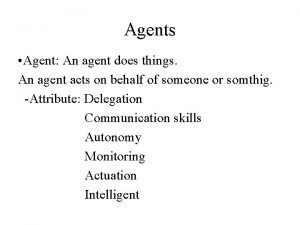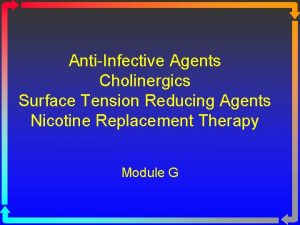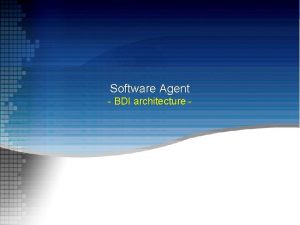ANTIINFECTIVE AGENTS Roselyn A Naranjo Antiinfective Agent is
















- Slides: 16

ANTI-INFECTIVE AGENTS Roselyn A. Naranjo

Anti-infective Agent - is - are a general drugs capable term that of acting encompasses against infection, antibacterials, by inhibiting antibiotics, the spreadantifungals, or by killing the antiprotozoans infectious agent. and antivirals.

CHEMOTHERAPHY -- is the use of chemical substances is the use of medicines (or drugs) to -is the study and use of chemical treat disease. to treat disease. In its modern-day agents that are selectively more toxic use, it refers to cytotoxic drugs used to the invading organism. -to treat cancer or the combination of can destroy cancer cells that have - it is the cure of an infectious disease metastasized, or spread to parts of these drugs into a standardized without injury to the host. body far away from the primary treatment regimen. (original) tumor.

Cytotoxic Cells - a cytotoxic T cell (also known as TC, CTL, TKiller cell or killer T cell) belongs to a sub-group of T lymphocytes (a type of white blood cell) which are capable of inducing the death of infected or somatic tumor cells. - they kill cells that are infected with viruses (or other pathogens ), or are otherwise damaged or dysfunctional.

Selective toxicity - is the property of certain chemicals to destroy one form of life without harming another. - the cornerstone of modern antimicrobial chemotherapy. Paul Ehrlich - discovered the antibacterial dyes and parasitic activity of organic arsenical.

Classification of chemotherapeutic Agents 1. Chemical Type 2. Biological Properties 3. Therapeutic indicators Types of Anti-infective agent according to source: 1. Antibiotics – derived from natural source or semi-synthetically prepared. 2. Antimicrobials – produced from synthetic substances.

Classification of Local Anti-infective Agents 1. Antiseptic - are compounds that kill or prevent the growth of microorganism when applied to living tissue. Criteria of an ideal Antiseptic * exerts rapid and sustained lethal action against microorganism (narrow and broad spectrum) * retain activity in the presence of body fus including pus * non-irritating to tissues * non-allergenic * lack systemic toxicity when applied to skin or mucous membrane * does not interfere with healing

Classification of Local Anti-infective Agents 2. Disinfectant - is an agent that prevents infection by the destruction of pathogenic microorganisms when applied to inanimate objects Criteria of an ideal disinfectant * exerts a rapid lethal action against all potentially pathogenic microorganisms and spores. * has good penetrating power into organic matter * compatible with organic compounds (especially soap) * not inactivated by living tissues * non-corrosive * esthetically desirable (non-staining and odorless)

ALCOHOLS AND RELATED COMPOUNDS A. Alcohol - also known as ethanol, wine spirit, Cologne spirit. - has burning taste and flammable. - miscible with water and other organic solvents. - fermentation product from grain and other carbohydrates. - most widely abused of all recreational drugs. - metabolized in the liver to aldehyde then to acetic acid and finally to carbon dioxide and water.

Classification of Local Anti-infective Agents A. Alcohol The antibacterial action of alcohol is due to the denaturing effect on proteins. coagulates 100% ethyl alcohol 70% ethyl alcohol

Uses: - antiseptic, preservative, mild counter-irritant or solvent of pharmaceutical preparations including spirits, tinctures and fluidextracts. - rubbing alcohol is used as astringent, rubefacient, refrigerant and mild local anesthetic. - alleviate pain of neuralgia by injecting alcohol to nerve and ganglia. - used internally in diluted forms as a mild sedative, as a weak vasodilator, as carminative and as source of energy.

Types of alcohol Denatured alcohol - is ethanol that has been rendered unfit for use in intoxicating beverages by the addition of other substance. Completely denatured alcohol - contains added wood alcohol and benzene and is unsuitable for either external or internal use. Specially denatured alcohol - is ethanol treated with one or more substances so that its use may be permitted for specialized purposes. Examples are methanol for plant extracts Iodine in alcohol for tincture of iodine

ALCOHOLS AND RELATED COMPOUNDS B. Dehydrated Ethanol - also known as absolute alcohol - it contains not less than 99% by weight of C 2 H 5 OH. - it is prepared by azeotropic distillation of an ethanol and benzene mixture. - it has a very high affinity of water and must be stored in tightly sealed containers. - it is use primarily as chemical agent, but it has also been injected for the local relief of pain in carcinoma and neuralgia.

ALCOHOLS AND RELATED COMPOUNDS C. Isopropyl alcohol, USP - it is a clear, colorless liquid having a characteristic odor and slightly bitter taste. It is considered a suitable substitute for ethyl alcohol for most external uses, but it must not be taken internally. - it is prepared commercially by the sulfuric acid-catalyzed hydration of propylene.

Uses: · - it is rapidly bactericidal in the concentration range of 50% to 95%. - 40% concentration is considered equal in antiseptic power to a 60% ethanol concentration. - Azeotropic isopropyl alcohol, USP is used by diabetics

To be continued…
 Andrea naranjo blanco
Andrea naranjo blanco Distribuidora el naranjo
Distribuidora el naranjo Andy naranjo
Andy naranjo Vanidad claudio naranjo
Vanidad claudio naranjo Roselyn unegbu
Roselyn unegbu Roselyn valerin
Roselyn valerin Agent function vs agent program
Agent function vs agent program Oxidizing agent examples
Oxidizing agent examples Interactive english tutor peas
Interactive english tutor peas Standard reduction potential table
Standard reduction potential table Redox reaction in alkaline medium
Redox reaction in alkaline medium Linda wozniewski
Linda wozniewski What is physical weathering
What is physical weathering Multimolecular film emulsion
Multimolecular film emulsion 5 agents in developing personality
5 agents in developing personality Mechanism of action of thrombolytic agents
Mechanism of action of thrombolytic agents Weathering vs erosion vs deposition
Weathering vs erosion vs deposition
